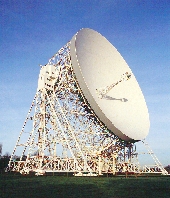HRH The Prince of Wales visits Jodrell Bank Observatory
28th April 2003

HRH The Prince of Wales came to Jodrell Bank to commemorate the "re-birth" of the Lovell telescope and he is seen here with Professor Andrew Lyne, the Director (right), and Professor Sir Bernard Lovell (centre). Click to enlarge
HRH The Prince of Wales visited The University of Manchester's Jodrell Bank Observatory in Cheshire on Monday, 28 April 2003, to commemorate the re-birth of its flagship Lovell Telescope following a major upgrade.
The ?2.5 million three-year upgrade saw the replacement of the 76-metre radio telescope's reflecting surface, which is now in pristine condition, and the installation of a new high-precision drive system. Together this allows it to operate over a four times greater range of frequencies so allowing exciting new science to be carried out. Professor Andrew Lyne, Director of Jodrell Bank, said that "this has been a great day in the life of the Observatory" and "he was delighted that Sir Bernard Lovell was present to see the telescope, now performing better than at any time in its existence, begin a new era in helping to keep UK astronomers at the forefront of astronomical research."
The restored Lovell Telescope, which has become a landmark on the Cheshire Plain since it was completed in 1957 by Sir Bernard Lovell, will continue its world-class research studying the formation of stars and discovering new pulsars in our own galaxy, the Milky Way, and seek out faint radio galaxies and quasars in the distant universe.
Sir Bernard, who met His Royal Highness during his visit, commented: "When built, the Telescope had only been expected to have an operational life of some 10 years. I am delighted that 45 years later, not only is it still in daily use, but is capable of a far wider range of observations. It is a truly magnificent achievement."
In addition to its use as single instrument, the Telescope is a key element of the UK's MERLIN high resolution radio-imaging array, based at Jodrell Bank, which routinely produces images of comparable quality than those of the Hubble Space Telescope. It is also regularly linked to telescopes across Europe and around the globe to make observations which have the highest resolution in astronomy. Professor Philip Diamond, Director of the MERLIN and VLBI National Facility based at Jodrell Bank, said that "the Lovell upgrade will now allow its power to be harnessed at the key frequencies used by MERLIN and the European VLBI Network. It will double the sensitivity of MERLIN and be able to play a significant role in extending the future expansion of VLBI into space."
The MERLIN and VLBI National Facility is operated by The University of Manchester on behalf of the Particle Physics and Astronomy Research Council (PPARC), who fund much of the research undertaken by the Telescope and who have played a key role in the implementation of the upgrade.
Professor Ian Halliday, Chief Executive of PPARC said,
"UK astronomy has gone from strength to strength. It is remarkable that the same national facility that enabled UK astronomers to make many important discoveries in the past remains at the forefront of international astronomical research in the future. Long may this continue."
During his visit, HRH also met teachers and students of the Catholic High School in Chester. The Observatory has links with the school and has helped in their successful bid to become a specialist Science College.
For further information, contact Lisa McCarthy or Alan Ferns, Public
Relations, The University of Manchester on 0161 275 2112/2114;
Gill Ormrod, PPARC Press Office, 01793 442012, e-mail: gill.ormrod@pparc.ac.uk Mobile: 0781 8013509.
Alastair Gunn, Jodrell Bank Observatory, 01477 572644, e-mail: agg@jb.man.ac.uk
Further images of the telescope and the upgrade work can be found here and here.
Background
1. The Lovell Telescope was the world's first fully steerable radio telescope when it was completed in 1957 and which has enabled scientists to observe the whole of the sky visible at Jodrell's latitude.
2. The telescope's powerful radar was the only western instrument able to track the carrier rocket of Russia's Sputnik I satellite in 1957 which brought it to the world's attention.
3. The ?2.5 million upgrade has been funded by the Government and the Wellcome Trust as part of the Joint Infrastructure Fund (JIF) initiative administered by the Particle Physics and Astronomy Research Council (PPARC).
4. The event marks the culmination of three years' work in which the rusting steel plates that made up the reflective surface of the Telescope have been replaced with new ones made of galvanised steel which have been set more precisely.
5. Very Long Baseline Interferometry (VLBI) arrays can achieve an even higher resolution than MERLIN arrays by combining the signals from widely spaced telescopes in VLBI arrays.
6. The event comes in the University's centenary year, which commemorates the creation of the University of Manchester as we know it today.
The Particle Physics and Astronomy Research Council (PPARC) is the UK's strategic science investment agency. It funds research, education and public understanding in four broad areas of science - particle physics, astronomy, cosmology and space science.
PPARC is government funded and provides research grants and studentships to scientists in British universities, gives researchers access to world-class facilities and funds the UK membership of international bodies such as the European Organisation for Nuclear Research, CERN, the European Space Agency and the European Southern Observatory. It also contributes money for the UK telescopes overseas on La Palma, Hawaii, Australia and in Chile, the UK Astronomy Technology Centre at the Royal Observatory, Edinburgh and the MERLIN/VLBI National Facility.
PPARC's Public Understanding of Science and Technology Awards Scheme provides funding to both small local projects and national initiatives aimed at improving public understanding of its areas of science.



